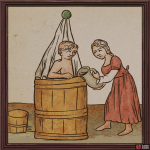Text
From the 13th century on, waste was dumped behind dwellings or buried in pits. Toilets consisted of cesspits topped with wooden structures with a seat or just a board. There were water drainage systems and no lack of free-standing latrines and outhouses, or at castles ‘privies’.
It was not uncommon for a latrine to be shared between several dwellings.
In inhospitable and badly-heated castles, there were sometimes bathrooms with bathtubs or even plunge pools. Bathing was attractive not just as a means of cleansing the body, but also for pleasure. In private houses a bathroom was a sign of luxury and high status. This did not mean that wealthier residents bathed more frequently; rather, they were able to put on clean clothes more often.
The most common hygiene practice was handwashing. Even in the poorest homes it was possible to find a basin with a water pitcher or a suspended water cistern with a faucet. The cleanest people were countryfolk, who would often wash in the stables or the river.
The Church was generally against bodily cleanliness, and so allowed priests or monks to bathe only twice a year–at Christmas and on the feast day of some chosen patron.
In spite of this there were public baths in each town where people went not just to get clean, but to socialize. Contrary to today’s notions, the people of that time were not very prudish and men and women shared the bathhouse together. Even the urban poor had the right to visit the baths, paid for by the municipality.


No Comments